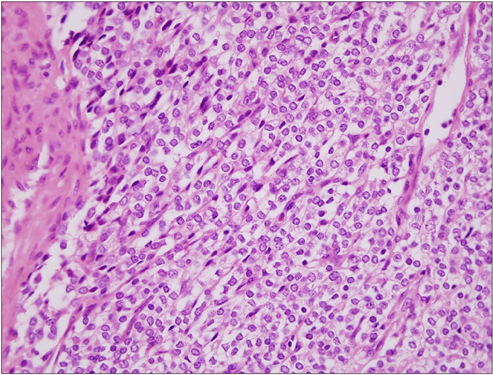Korean J Urol.
2012 Oct;53(10):733-736. 10.4111/kju.2012.53.10.733.
Primary Undifferentiated Penile Sarcoma in Adolescence
- Affiliations
-
- 1Department of Urology, Pusan National University Hospital, Busan, Korea. hongkooha@pusan.ac.kr
- 2Department of Pediatrics, Pusan National University Hospital, Busan, Korea.
- KMID: 1856995
- DOI: http://doi.org/10.4111/kju.2012.53.10.733
Abstract
- We report a case of primary penile undifferentiated sarcoma. A 16-year-old adolescent man visited Pusan National University Hospital complaining of a painless mass on his penis that was increasing in size. Magnetic resonance images revealed a 5x5-cm mass and pathological examinations revealed small round cell sarcomas with neuroendocrine differentiation. The tumor, which had metastatic pulmonary nodules, was treated by tumorectomy and systemic chemotherapy. Thirty-four months after the initial diagnosis, the patient was still alive without evidence of local recurrence or metastatic disease. This is our second case of an undifferentiated penile sarcoma.
Keyword
MeSH Terms
Figure
Reference
-
1. Hoebeke PB, Rottey S, Van Heddeghem N, Villeirs G, Pauwels P, Schrauwen W, et al. One-stage penectomy and phalloplasty for epithelioid sarcoma of the penis in an adolescent: part 2. Eur Urol. 2007. 51:1744–1747.2. Katsikas VS, Kalyvas KD, Ioannidis SS, Papathanasiou MV, Panagiotopoulou KP, Hitiroglou PM, et al. Leiomyosarcoma of the penis. Sarcoma. 2002. 6:75–77.3. Dominici A, Delle Rose A, Stomaci N, Pugliese L, Posti A, Nesi G. A rare case of leiomyosarcoma of the penis with a reappraisal of the literature. Int J Urol. 2004. 11:440–444.4. El Hayek OR, Ibrahim R, Lemos GC. Pleomorphic undifferentiated sarcoma of the penis. Clinics (Sao Paulo). 2008. 63:841–842.5. Sirikci A, Bayram M, Demirci M, Bakir K, Sarica K. Penile epithelioid sarcoma: MR imaging findings. Eur Radiol. 1999. 9:1593–1595.6. Pawel BR, Hamoudi AB, Asmar L, Newton WA Jr, Ruymann FB, Qualman SJ, et al. Undifferentiated sarcomas of children: pathology and clinical behavior--an Intergroup Rhabdomyosarcoma study. Med Pediatr Oncol. 1997. 29:170–180.7. Enzinger FM. Epitheloid sarcoma. A sarcoma simulating a granuloma or a carcinoma. Cancer. 1970. 26:1029–1041.8. Fetsch JF, Davis CJ Jr, Miettinen M, Sesterhenn IA. Leiomyosarcoma of the penis: a clinicopathologic study of 14 cases with review of the literature and discussion of the differential diagnosis. Am J Surg Pathol. 2004. 28:115–125.9. Sundersingh S, Majhi U, Narayanaswamy K, Balasubramanian S. Primary leiomyosarcoma of the penis. Indian J Pathol Microbiol. 2009. 52:447–448.10. Glucker E, Hirshowitz B, Gellei B. Leiomyosarcoma of the glans penis. Case report. Plast Reconstr Surg. 1972. 50:406–408.
- Full Text Links
- Actions
-
Cited
- CITED
-
- Close
- Share
- Similar articles
-
- Sinonasal Undifferentiated Pleomorphic Sarcoma in Five Patient Cases
- Cutaneous Metastatic Undifferentiated Pleomorphic Sarcoma from a Mediastinal Sarcoma
- Primary Undifferentiated High-Grade Pleomorphic Sarcoma in the Perihepatic Space: A Report of a Case
- A case of primary retroperitoneal undifferentiated endometrial stromal sarcoma after concurrent chemoradiation therapy for cervical cancer
- A Case of Pleomorphic Dermal Sarcoma Showing Characteristics of Myxoinflammatory Fibroblastic Sarcoma




